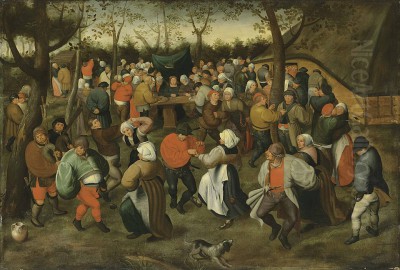
Marten van Cleve the Elder (c. 1527 – before 24 November 1581) stands as a significant Flemish painter of the 16th century, renowned for his vibrant genre scenes and, to a lesser extent, landscape and religious paintings. Active primarily in Antwerp, he emerged during a period of rich artistic production in the Southern Netherlands, contributing a distinctive voice to the depiction of everyday life, particularly that of the peasantry. His work, while deeply influenced by his eminent contemporary Pieter Bruegel the Elder, carved its own niche through a prolific workshop and a keen eye for the bustling, unvarnished realities of his time.
Early Life and Artistic Foundations
Born in Antwerp around 1527, Marten van Cleve was immersed in an artistic environment from a young age. His father, Willem van Cleve the Elder, was a painter, providing Marten with his initial instruction in the craft. This familial introduction to the arts was common in the period, with skills and workshop practices often passed down through generations. The city of Antwerp itself was a burgeoning metropolis, a centre of international trade and a magnet for artists and craftsmen, fostering a competitive yet stimulating atmosphere for creative development.
To further hone his skills, Marten van Cleve is documented as having joined the extensive workshop of Frans Floris de Vriendt (c. 1519/20 – 1570) between 1553 and 1555. Floris was one of Antwerp's leading painters, a key figure in introducing Italian Renaissance ideals – Romanism – to the Netherlands. His studio was a veritable academy, training a host of influential artists, including Crispin van den Broeck, Frans Pourbus the Elder, and Lambert van Noort. Exposure to Floris's workshop would have provided Van Cleve with a sophisticated understanding of figure drawing, composition, and the large-scale production methods necessary to meet the demands of a thriving art market. In 1551, Marten van Cleve was officially enrolled as a master in the Antwerp Guild of Saint Luke, the city's venerable institution for painters and other artisans, a crucial step for any artist wishing to practice independently and take on pupils.
A Shift in Focus: From Landscape to Genre
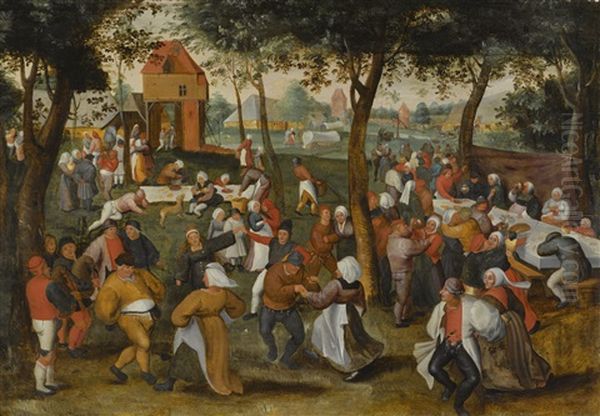
Initially, Marten van Cleve seems to have shown an inclination towards landscape painting, a genre gaining increasing popularity in the Netherlands. However, a significant shift in his artistic direction occurred, reportedly influenced by his brother, Hendrik van Cleve III (c. 1525 – 1589). Hendrik was himself an accomplished painter, particularly known for his landscapes and cityscapes, often with an Italianate flavour, reflecting his travels to Italy. It is suggested that Hendrik encouraged Marten to concentrate on figure painting, specifically the burgeoning field of genre scenes.
This transition proved pivotal. Marten van Cleve found his true calling in depicting the lives of ordinary people, especially peasants. His canvases came alive with scenes of rustic weddings, boisterous kermesses (village fairs), lively dances, and the daily toil and simple pleasures of rural communities. This focus aligned him with a broader trend in Netherlandish art, where artists like Pieter Aertsen and Joachim Beuckelaer were already exploring market scenes and kitchen interiors, bringing a new dignity and interest to everyday subjects. However, Van Cleve’s particular emphasis on peasant life placed him in closer thematic proximity to Pieter Bruegel the Elder.
The Bruegelian Orbit: Influence and Independence
The shadow of Pieter Bruegel the Elder (c. 1525/30 – 1569) looms large over any discussion of 16th-century Flemish genre painting, and Marten van Cleve’s work is no exception. The two artists were contemporaries in Antwerp, and Van Cleve was undoubtedly familiar with Bruegel's groundbreaking depictions of peasant life. There are undeniable thematic and stylistic parallels: the crowded compositions, the robust and often caricatured figures, the earthy palettes, and the focus on communal activities.
Works such as Van Cleve's numerous versions of A Peasant Wedding or The Outdoor Wedding Dance clearly echo Bruegel’s famous treatments of similar subjects. The energy, the somewhat crude vitality of the figures, and the detailed observation of rustic customs are all hallmarks shared by both artists. Similarly, Van Cleve’s depictions of children's games or proverbs, like The Parable of the Blind Leading the Blind, directly engage with themes popularized by Bruegel.
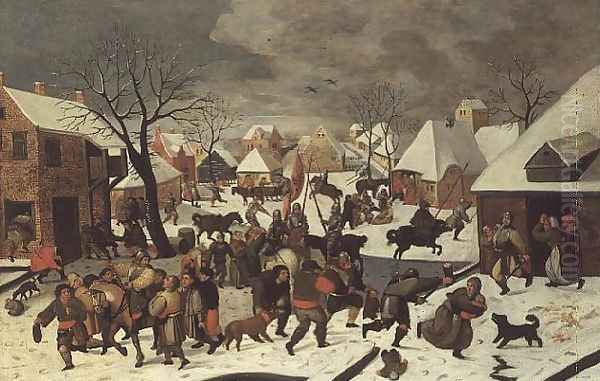
Despite these strong affinities, art historians generally concur that Marten van Cleve was not a mere imitator. While Bruegel’s influence is palpable, Van Cleve developed his own distinct artistic personality. His figures, though often less monumental than Bruegel's, possess a lively animation. His compositions, while sometimes appearing less formally structured than Bruegel's carefully orchestrated designs, convey a sense of spontaneous, bustling activity. Van Cleve's workshop also played a crucial role in popularizing these Bruegelian themes, producing numerous versions and variations that catered to a broad market. This dissemination, in turn, likely influenced artists of the next generation, including Pieter Brueghel the Younger and Jan Brueghel the Elder, who continued to explore and replicate their father's popular compositions, a market demand that Van Cleve's studio had helped to cultivate.
The Workshop and Artistic Production
Between approximately 1560 and 1570, Marten van Cleve operated a large and highly productive workshop in Antwerp. This was a period of significant output, where he and his assistants produced a considerable number of paintings. The workshop system was standard practice, allowing a master painter to meet market demand by employing apprentices and journeymen to assist with various stages of the painting process, from preparing panels and grinding pigments to painting backgrounds or less critical figures.
A notable aspect of Van Cleve's workshop was the production of "original replicas." This meant that successful compositions were often repeated, sometimes with minor variations, to satisfy multiple clients. This practice was common and did not carry the negative connotations it might today; it was a way for popular images to be more widely disseminated. The quality of these workshop productions was generally high, indicating Van Cleve's effective management and the skill of his collaborators. His sons, Gillis van Cleve, Marten van Cleve the Younger, and possibly Hans Jordaens (if distinct from the elder Hans Jordaens I, who was a contemporary), also became painters and likely received their training within the family workshop, continuing the artistic lineage. Marten van Cleve is recorded as having registered five official pupils with the Guild, one of whom later achieved the status of master himself.
Key Themes and Representative Works
Marten van Cleve's oeuvre is characterized by a recurring set of themes, primarily centered on peasant life and festivities. His paintings offer a window into the social customs, attire, and environment of the 16th-century Flemish countryside.
Peasant Weddings and Festivities: This was arguably his most popular theme. Works like Outdoor Wedding, Peasant Wedding Dance, and The Festivities of the Rich and Poor capture the boisterous energy of these communal celebrations. They are filled with numerous figures eating, drinking, dancing, and interacting, often with a humorous or satirical undertone. These scenes provided ample opportunity to depict a wide range of human types and activities.

Rural Labors and Daily Life: Beyond celebrations, Van Cleve also depicted scenes of everyday peasant life and work. Kitchen Interior paintings show the domestic sphere, while other works might allude to agricultural tasks or village interactions. These scenes, while less overtly dramatic than the festival pictures, provide valuable insights into the material culture of the time.
Proverbs and Moralizing Scenes: Following a trend popularized by Bruegel, Van Cleve also painted scenes illustrating proverbs or with moralizing content. The Parable of the Blind Leading the Blind is a prime example, depicting the biblical allegory with a group of stumbling figures, a theme also famously treated by Bruegel. Such works often carried didactic messages about human folly or the transience of life.
Religious Subjects: While best known for genre, Van Cleve also produced religious paintings. These often incorporated genre elements, with biblical scenes set in contemporary Flemish landscapes or interiors, populated by figures in 16th-century dress. St. Martin's Charity, for instance, might depict the saint in a snowy village scene bustling with local inhabitants. His Massacre of the Innocents often features a winter landscape, a setting also used by Bruegel for this subject.
Allegorical and Mythological Scenes: Less common, but present, are allegorical works. His depictions of the Twelve Months or The Four Seasons allowed him to combine landscape elements with figures engaged in activities typical of each period.
His style is generally characterized by lively, somewhat elongated figures, often with expressive, almost caricatured faces. He employed a relatively bright palette, though sometimes with earthy tones dominating his peasant scenes. His brushwork could be detailed, particularly in rendering costumes and objects, but also possessed a fluid quality that contributed to the dynamism of his compositions. Other painters active in similar thematic areas during or slightly after his time, whose works provide a broader context, include Lucas van Valckenborch, known for his landscapes with small figures and seasonal depictions, and Hans Bol, who also created detailed scenes of country life, often in smaller formats. Later artists like David Vinckboons, Adriaen Brouwer, and David Teniers the Younger would continue and evolve this tradition of Flemish genre painting.
Personal Anecdotes and Historical Perception
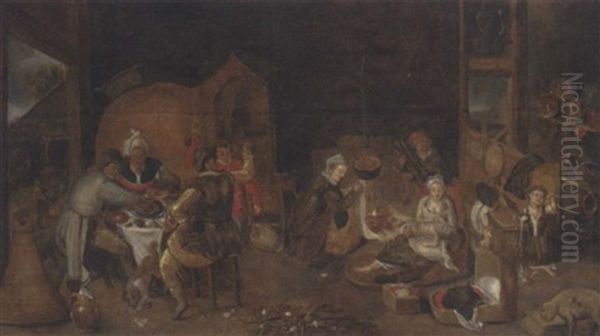
Historical accounts, notably by the early art biographer Karel van Mander in his Schilder-boeck (1604), paint a somewhat eccentric picture of Marten van Cleve's personality. Van Mander describes him as leading a rather dissolute life and suggests he suffered from "gout and rheumatism," which eventually led to his death. There are also more colorful, if perhaps apocryphal, stories, such as him being "mentally deranged" or parading through the streets in clothes adorned with rosin varnish. Another anecdote mentions an extramarital affair with a serving woman.
While such biographical details add a layer of intrigue, their historical accuracy can be difficult to ascertain fully. Van Mander, writing a few decades after Van Cleve's death, relied on available sources and hearsay, and his accounts sometimes aimed to create memorable character sketches as much as to provide factual biographies. Regardless of the veracity of these specific tales, they contribute to the image of a somewhat unconventional artistic personality. What is more certain is his professional success, evidenced by his large workshop and the widespread dissemination of his compositions.
Attribution Challenges and Scholarly Reassessment
The study of Marten van Cleve's work has been complicated by issues of attribution. His style, being in the popular Bruegelian vein, and the prolific output of his workshop, which included many unsigned pieces and replicas, have sometimes made it difficult to distinguish his autograph works from those of his assistants, followers, or even contemporary imitators of Bruegel.
For a long time, many of his paintings were misattributed, often to members of the Bruegel family, particularly Pieter Brueghel the Younger, who frequently painted similar subjects. Scholarly research in more recent decades has worked to clarify Van Cleve's oeuvre, reattributing works based on stylistic analysis and documentary evidence. For example, certain versions of The Parable of the Blind or peasant wedding scenes, once given to other artists, are now confidently assigned to Van Cleve or his workshop. The rediscovery of signed or well-documented pieces has helped establish a firmer basis for these attributions. This ongoing process of scholarly reassessment continues to refine our understanding of his individual contribution and the specific characteristics of his hand.
Later Life, Death, and Legacy
Marten van Cleve's productive career was relatively short. He died in Antwerp sometime before 24 November 1581, the date on which his death duties were paid. He was likely in his early to mid-fifties. As mentioned by Van Mander, he reportedly suffered from debilitating illnesses like gout and rheumatism in his later years.
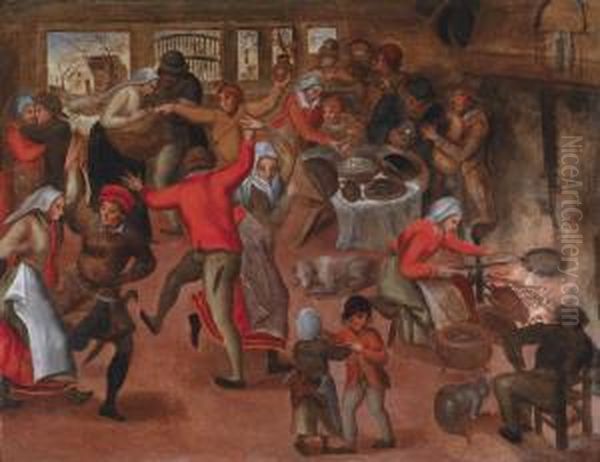
Despite the challenges of attribution and the towering presence of Pieter Bruegel the Elder, Marten van Cleve the Elder holds an important place in the history of Flemish art. His workshop was instrumental in popularizing genre scenes, particularly those depicting peasant life, making them accessible to a wider audience. He successfully navigated the artistic currents of his time, absorbing the influence of major figures like Frans Floris and Pieter Bruegel the Elder, yet forging a recognizable style of his own.
His impact extended to subsequent generations. The continued demand for Bruegelian themes, which his workshop helped to sustain, provided a fertile ground for artists like Pieter Brueghel the Younger and Jan Brueghel the Elder. More broadly, Van Cleve contributed to the rich tradition of genre painting that would become a hallmark of Netherlandish art, influencing later Flemish and Dutch masters who continued to explore the varied facets of everyday life. His works remain valuable not only for their artistic merit but also as lively historical documents, offering a vibrant glimpse into the world of 16th-century Flanders. His ability to capture the energy and character of peasant life ensures his enduring appeal and significance.